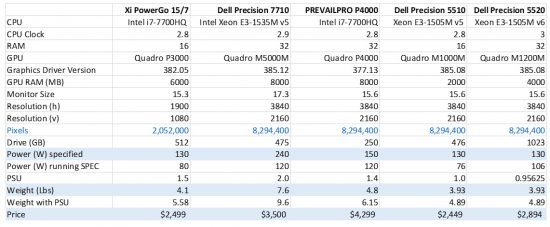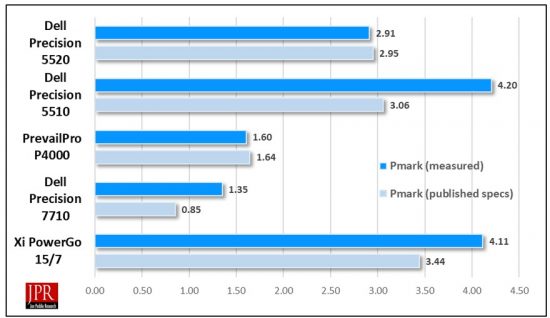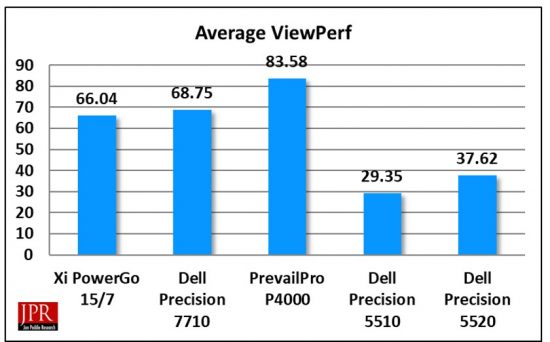Five different machines.
At SIGGRAPH, PNY introduced their first mobile workstation products, the Prevailpro P4000 and P3000, while Dell announced a new Anniversary Edition thin and light 5520 mobile workstation. We tested a Prevailpro P4000 and 5520 against three other workstations and offer the results here.
When evaluating a mobile workstation, from our point of view, we think Pmark with weight (pounds) included is a reasonable guide. However, there are (at least) two ways to use Pmark results.

First, let’s review what goes into Pmark: Price, Performance, Power, and in the case of a mobile device, Pounds.
The Pmark equation is straight forward:
- Pick a performance number that favors your favorite product, and then use the published specifications.
- Run a battery of tests and take the average score, using published specifications.
- Use an average score, while measuring the actual power being consumed during the test.
- Finally, for our purposes, is to use number three above and include the weight of the external power supply (PSU).
We will show you our results for items two and four.
The machines
Many people will look at the following list and say that’s not a fair comparison given different CPUs, divergent GPUs, and variable screen size. Yep, all true, and so what? It’s a comparison. If these variances bother you, stop reading now, you have better things to do with your time.

For the performance tests, we ran SPECviewperf 12.1, Cinebench R15, PassMark, and GeekBench 4. As you might expect, some machines did better in one test than another, however, the Dell 7710 did best in all tests except SPECviewperf, and in that one the PNY P4000 did 22% better than the 7710, which for users requiring ultimate graphics performance may very well close the deal in favor of PNY.
But, in terms of the Pmark, anyway you want to use it, once again the @Xi PowerGO 15/7 took the prize in specifications, while the Del 5510 won on measured results.

Many reviewers will simply use SPECviewperf for evaluating a workstation, and that’s what the consortium’s test was designed for. SPECviewperf, developed and maintained by the SPEC organization, is a tried and trusted series of tests that incorporates several real-world applications, and so it is not considered a simulated test, like the others.
SPECviewperf uses Catia, Creo, Maya, Siemens NX, and Solidworks, as well as a data set from MRI files, and energy.
Each one of those tests generates a unique score, so if you are working in a specific field, CAD for example, then you can look at the Siemens NX or Catia results to judge how well the workstation you are considering might do on your data.

For the purposes of calculating the Pmark, we took the average of those test scores for the SPECviewperf entry in our overall average performance number. However, SPECviewperf is an important enough test, we thought its results should be shown separately.

Depending upon what your personal preferences are, one of these machines should satisfy you. Jon, for example, wants a lot of pixels, and no weight. The Dell 5520 is his choice. Alex likes a big high-resolution screen and isn’t afraid of a little bulk, so he tends toward the Dell 7710. I’m a power freak and for me the PNY is the best choice, while Kathleen thinks the @Xi is the coolest looking, well performing machine. Notice, none of us even put price in the equation. Generally speaking, we don’t think many users of professional workstations, especially mobile systems, put price very high on their list.
What do we think?
The machines have a mix of Xeon and i7 CPUs, but this will probably be the last year we’ll see that. With the introduction of the W series Xeon processors from Dell, workstation suppliers will be strongly discouraged from using an i7 as a workstation processor. Intel may even go so far as to punish such companies by denying marketing dollars.
Also, late this year AMD’s workstation CPU will be out; and possibly late this year, but early next year for sure we will start to see AMD CPU based workstations, both mobile and desktop/side/under/rack. We also expect to see AMD APU entry-level workstations, mostly in the mobile segment.
However, BOXX just announced a Threadripper-based workstation, and we’ll be testing that soon.
Epilog—cons of Pmark
Alex Herrera isn’t a fan of Pmark, since it applies equal value to all the metrics (e.g., performance, price, power, weight) when buyers will be looking at different things. He thinks price–performance is worth making a “combo” mark, but beyond that, you’ve got buyers that care about performance far more than weight, for example. Or vice versa. Ditto for power.
For performance, he doesn’t think it’s true that “many reviewers will simply use SPECviewperf for evaluating a workstation, and that’s what the consortium’s test was designed for.”
SPECviewperf is one good test, but it definitely is not a comprehensive system-level test. It stresses the rendering side only, mostly GPU. Cinebench is also pure rendering. Alex thinks SPECwpc is a much better, holistic battery of tests which does evaluate the entire system (and which happens to include virtually all the SPECviewperf datasets).





